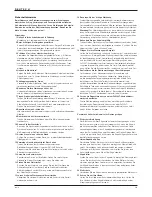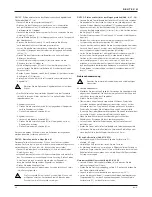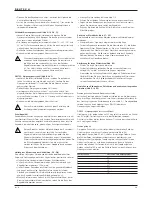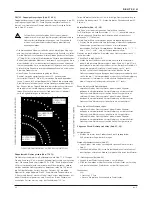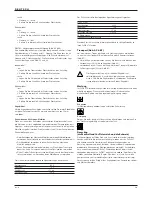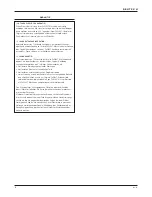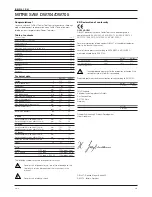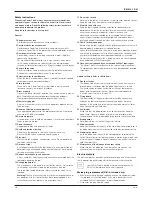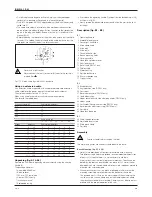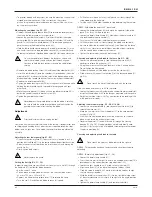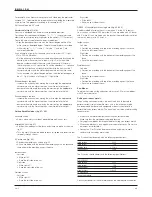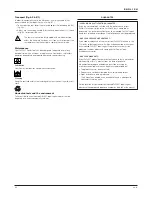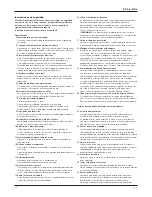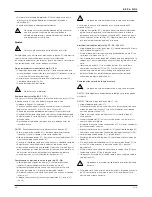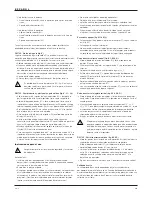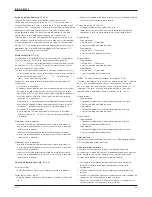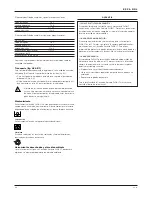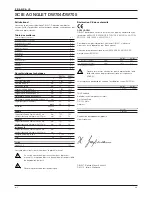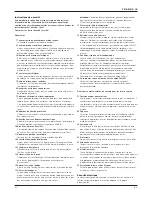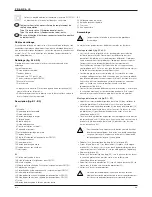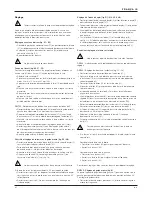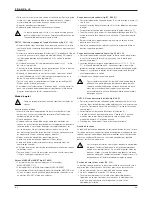
en - 7
24
E N G L I S H
For example, if you measure the corner of an 8 sided box, the protractor
will read 135°. To determine the proper mitre setting, divide the measured
angle by two. The proper mitre setting in this example is 67
1
/
2
.
Set this angle on the 90° scale.
Vernier scale (fig. U1 - U3)
Your saw is equipped with a vernier scale for added precision.
For settings that require partial degrees (
1
/
4
°,
1
/
2
°,
3
/
4
°), the vernier scale
allows you to accurately set mitre angles to the nearest
1
/
4
° (15 minutes).
To use the vernier scale follow the steps listed below.
• Align the desired vernier mark with the closest degree mark on the
mitre scale, as described below. The plastic vernier plate is inscribed
with marks for
1
/
4
°,
1
/
2
°,
3
/
4
° and 1°. Only the
1
/
2
° and the 1° are
numerically labelled.
As an example, assume that the angle you want to mitre is 24
1
/
4
° right.
• Turn OFF the Mitre Saw.
• Set the mitre angle to the nearest whole degree desired by aligning the
centre mark in the vernier scale, shown in fig. U1, with the whole
degree number etched in the mitre scale. Examine fig. U2 closely;
the setting shown is 24° right mitre. To set the additional
1
/
4
°, squeeze
the mitre arm lock and carefully move the arm to the right until the
1
/
4
°
vernier mark aligns with the closest degree mark on the mitre scale.
In this example, the closest degree mark on the mitre scale happens to
be 25°. Fig. U3 shows a setting of 24
1
/
4
° right mitre.
When mitring to the right:
- increase the mitre angle by moving the arm to align the appropriate
vernier mark with the closest mark on the mitre scale to the right.
- decrease the mitre angle by moving the arm to align the appropriate
vernier mark with the closest mark on the mitre scale to the left.
When mitring to the left:
- increase the mitre angle by moving the arm to align the appropriate
vernier mark with the closest mark on the mitre scale to the left.
- decrease the mitre angle by moving the arm to align the appropriate
vernier mark with the closest mark on the mitre scale to the right.
Cutting Base Mouldings (fig. V1 - V4)
Vertical position
• Always make a dry run without power before making any cuts.
Straight 90° cuts (fig. V1)
• Position the wood against the fence and clamp it in place as shown in
fig. V1.
• Turn the saw ON, allow the blade to reach full speed and lower the arm
smoothly through the cut.
45° mitre cuts (fig. V2)
• Position the moulding as shown in fig. V2.
• All cuts are made with the back of the moulding against the fence and
the bottom of the moulding against the base.
Inside corner
- Left side
• Mitre left 45°.
• Save the left side of the cut.
- Right side
• Mitre right 45°.
• Save the right side of the cut.
Outside corner
- Left side
• Mitre right 45°.
• Save the left side of the cut.
- Right side
• Mitre left 45°.
• Save the right side of the cut.
DW705 - Horizontal position using bevel (fig. V3 & V4)
Another method of making the cut is to make a 0° mitre, 45° bevel cut.
Your saw can cut a bevel 200 mm wide. All cuts are made with 45° bevel
and 0° mitre. All cuts are made with the back of the moulding laying flat on
the saw as shown in fig. V3 and V4.
Inside corner
- Left side
• Position the moulding with top of the moulding against the fence.
• Save the left side of the cut.
- Right side
• Position the moulding with the bottom of the moulding against the
fence.
• Save the left side of the cut.
Outside corner
- Left side
• Position the moulding with the bottom of the moulding against the
fence.
• Save the right side of the cut.
- Right side
• Position the moulding with top of the moulding against the fence.
• Save the right side of the cut.
Saw Blades
To obtain the stated cutting capacities, always use 305 mm saw blades
with 30 mm arbor holes.
Cutting non-ferrous metals
When cutting non-ferrous metals, the machine is only to be used to
perform vertical straight and mitre cross-cuts in the mitre saw mode.
We recommend that bevel and compound mitre cuts should not be
performed in non-ferrous metals. The machine is not to be used for cutting
ferrous metals.
• Always use a material clamp when cutting non-ferrous metals.
Make sure that the workpiece is clamped securely.
• Only apply saw blades that are qualified for cutting non-ferrous metals.
• When using lubricants, only apply wax or separation spray. Do not use
emulsions or similar fluids.
• Connect an FI or DI switch between machine and mains to avoid
residual risks caused by metal swarf.
The FI switch should comply with the following specifications:
rated voltage
230 V
rated current
16 A
reaction time
< 15 ms
fusing current
30 mA
The DI switch should comply with the following specifications:
DIN VDE 0661
rated voltage
230 V
rated current
16 A
fusing current
30 mA
all-pole cutoff
L+N+PE
PE monitoring
low-voltage release
Consult your dealer for further information on the appropriate accessories.

